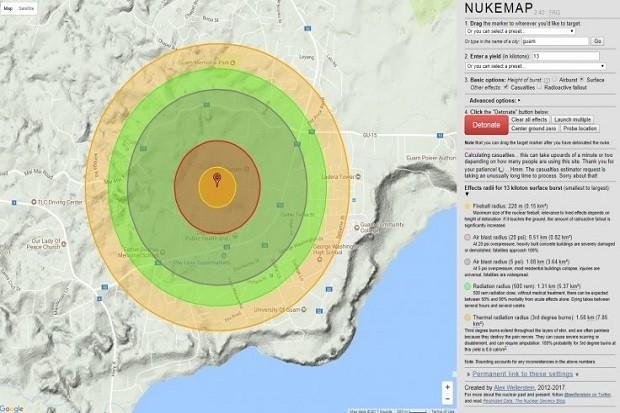KYOTO - World citizens are curious about what happens if Guam is bombed nuclear North Korea (North Korea) and Pyongyang bombed nuclear United States (US). The Nukemap interactive website provides the answer.

Nukemap is an interactive site that can be configured to show what will happen if the US and North Korea drop nuclear bombs in Pyongyang and Guam.
The site was created by Alex Wellerstein, a computer programmer and nuclear weapons historian. Nukemap estimates details of the size of a nuclear bomb fireball, air blast, thermal radiation and how many people are killed and injured in the bombed area.
As reported earlier, Kim Jong-un's regime in Pyongyang threatened to attack US military bases in Guam within days. President Donald Trump and the Pentagon have warned Kim Jong-un's regime not to start a war because the impact on Pyongyang's government and people will be terrible.
The interactive website has been flooded with internet user traffic in recent days after concerns over the two countries' nuclear war are on the rise.
"I woke up in Kyoto and Nukemap went crazy, and everyone was asking about the nuclear command chain! What will happen, "said Wellerstein who wrote it on Twitter, as quoted IB Times, Thursday (10/08/2017) night.
According to Nukemap, if the largest nuclear weapon developed by North Korea, a 12 to 23.7 kiloton bomb tested in 2016, hitting the heart of Guam, would create a fireball with a radius of between 210 and 290 meters.
Radiation with 50-90 percent mortality will spread between 3 to 6 square kilometers, causing deaths between several hours to several weeks. A 5psi air explosion, in which most residential buildings collapse will cover an area between 3 to 5.5 square kilometers. While the thermal radiation that causes third-degree burns will spread to an area of 12.6 square kilometers.
Nukemap estimates that the blast will cause 3,000 deaths and 12,700 injuries among 163,000 Guam residents, who are home to US military bases.

On the other hand, if the United States attacks the North Korean capital, Pyongyang, with its largest nuclear weapons weapons weapon, the 1,200-kiloton B-83 bomb, it is estimated that one million people will be killed and 843,000 injured.
The fireball blast will cover an area of 5.7 square kilometers. Then the explosion of air will lead to many collapsed residential buildings covering an area of 74 square kilometers. Thermal radiation that causes third-degree burns will spread to an area of 420 square kilometers.
But the weapon is relatively small compared to the Soviet 50 megaton Tsar Bomb, the largest hydrogen bomb ever tested in 1961. The giant bomb has a diameter of 2.1 meters and weighs 27,000 kg.
Nukemap estimates, if the giant bombs fall in Pyongyang, it will produce a fireball that covers 67 square kilometers. Then, an air explosion will cover 1,350 square kilometers and thermal radiation will cover 11,300 square kilometers. More than 2.9 million people will be killed and another 1.3 million will be hurt.